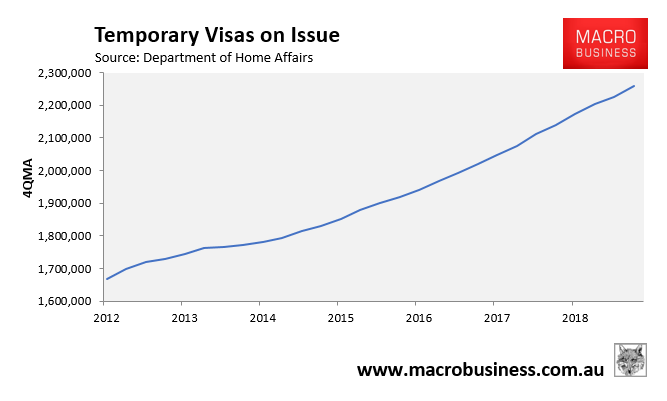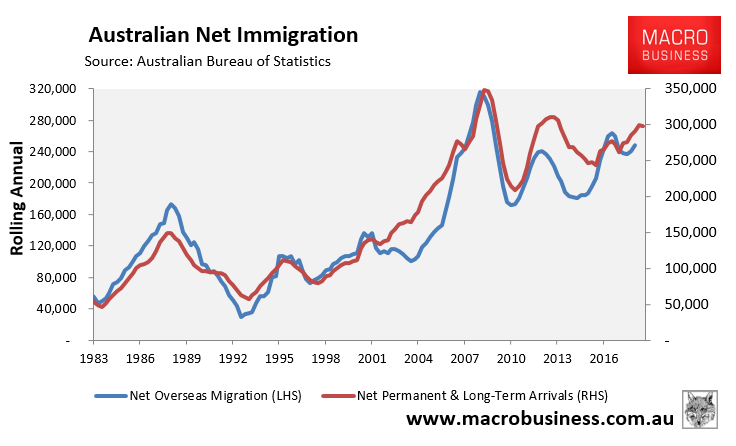It never ceases to amaze how our dishonest governments pull the wool over voters’ eyes on immigration.
In Australia, we’ve recently witnessed the Morrison Government wax lyrical about reducing immigration to “relieve congestion in the cities”, only to then see the number of temporary visas balloon to unprecedented levels, as illustrated below:

Accordingly, net overseas migration (NOM) continues to rise:

With NOM projected to increase further in the April Federal Budget:

We are witnessing similar dishonesty across the pond in New Zealand.
In the lead-up to the September 2017 general election, the New Zealand Labour Party launched a plan to reduce immigration by around a third in a bid to relieve chronic housing and infrastructure pressures (especially around Auckland):
…in recent years our population has been growing rapidly as record numbers of migrants arrive here. This has happened without the Government planning for the impact immigration is having on our country… This has contributed to the housing crisis, put pressure on hospitals and schools, and added to the congestion on roads…
Labour will… take a breather on immigration… In total, these changes are estimated to reduce net migration by 20,000-30,000. Without these changes there would be up to 10,000 more houses needed and up to 20,000 more vehicles on our roads annually.
Yesterday, Labour’s immigration minister, Iain Lees-Galloway, announced a dramatic expansion of access to lower-wage temporary migrant workers for New Zealand businesses – a move that unambiguously breaks its election commitment:
The Government has announced plans to make it easier for employers to bring temporary workers into the country.
And it has also announced a reversal of the previous clampdown by the National Government in 2017 on families of lower paid temporary workers being allowed to also come into New Zealand…
There will be a phased introduction, with the new rules fully taking effect in 2021.
The Government hasn’t put any numbers around how many workers will be allowed in under the new rules.
A feature of the new plan is that it will include “sector agreements” with various targeted industries that have a high reliance on migrant workers. Sectors identified for initial negotiations include: residential care (including aged care), meat processing, dairy, forestry, road freight transport, and tourism and hospitality. The construction and horticulture and viticulture sectors are also potential candidates…
Lees-Galloway says the new rules “will assist around 25-30,000 businesses get the workers they need to fill skills shortages”. He says currently there are over 54,000 workers on the main employer assisted work visa – the essential skills visa…
“For jobs with very high pay (200% or twice the median wage) there will be no labour market test requirement (that is, a check as to whether there are New Zealanders available).”
And additionally, the document also says: “For those paid above the median wage and in the parts of the country where there are fewer New Zealanders available there will be no labour market test.”
The median wage is given as $52,000…
The Government will reinstate the ability for lower-paid foreign workers to support their partner and children to come to New Zealand for the length of their visa. This was restricted in 2017…
Dependent children of a lower-paid worker will have access to primary and secondary education as subsidised domestic students.
So basically, broad sectors of New Zealand’s economy will be given easy access to low-paid migrant workers. Migrants paid below the median $52,000 wage will also be permitted to bring their partners and children along for the ride, with taxpayers subsidising their children’s education.
This policy will resonate especially strongly with migrant workers from developing nations (e.g. India), who can be expected to flood into New Zealand as a result of these reforms, thereby crushing both wages and liveability.
In short, Jacinda Adern has broken her key election commitment to reduce immigration, while effectively declaring war on Labour’s traditional working class base.

